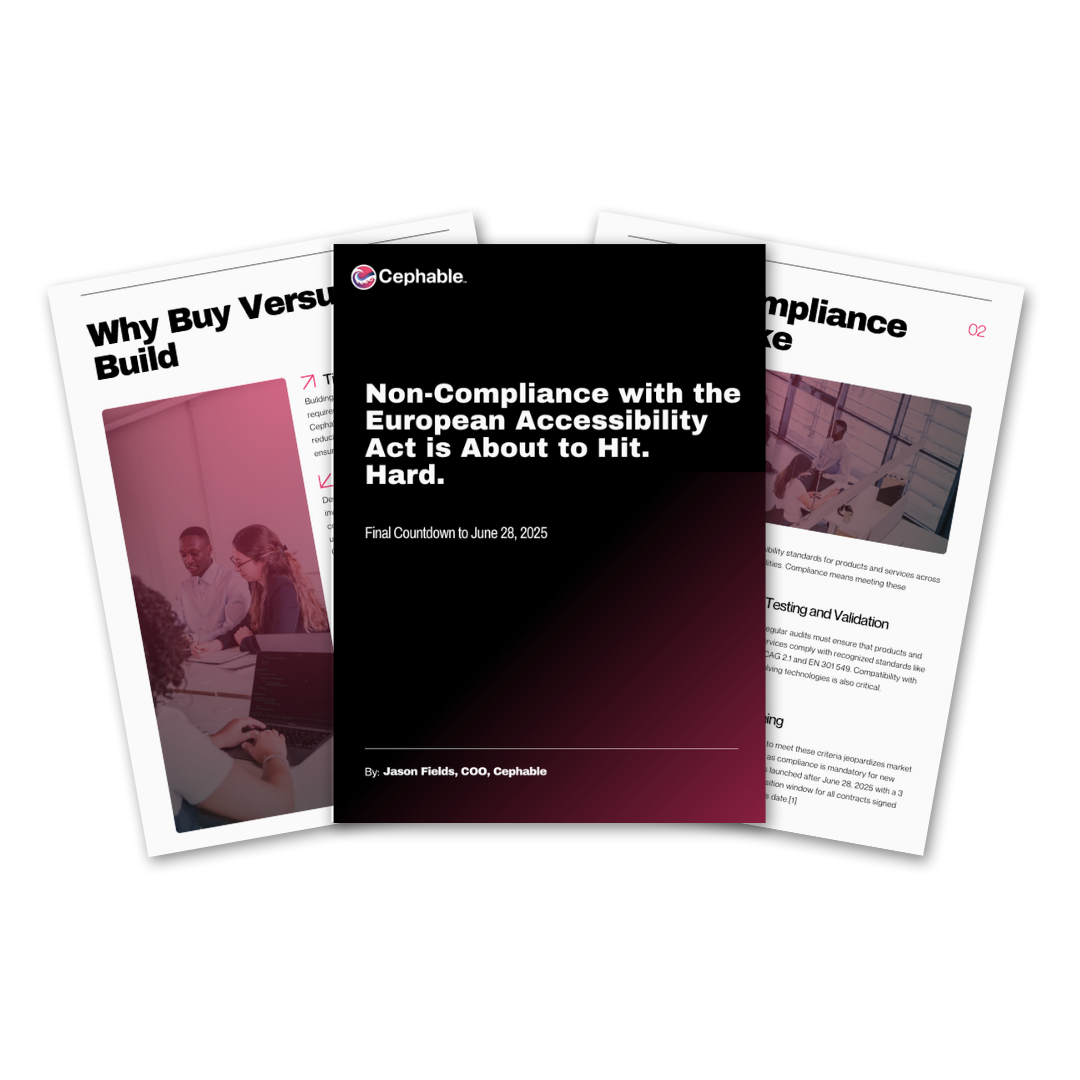A Note
As businesses, we thrive when we adapt to the evolving regulatory landscape. The European Accessibility Act (EAA) is not just another requirement to check off- it represents a pivotal shift towards inclusivity and equal access. Ensuring compliance isn’t merely about avoiding fines or keeping market access; it’s about embracing innovation that benefits everyone. At Cephable, we understand the challenges of meeting stringent accessibility standards while maintaining the pace of development. That’s why we’ve designed our SDKs to seamlessly integrate accessibility into your products, making compliance easier and faster. We’ve seen firsthand how inclusive design drives market growth, improves user satisfaction, and builds brand trust. Regulatory adherence isn’t just a legal obligation; it’s an opportunity to future-proof your business and demonstrate your commitment to a more equitable digital world. We’re here to help you navigate this journey with confidence. Let’s work together to keep your markets open and your innovation thriving.
– Jason Fields, COO of Cephable
What Compliance Looks Like
The European Accessibility Act (EAA) defines accessibility standards for products and services across the EU, ensuring they are usable by people with disabilities. Compliance means meeting these standards across key areas:
Software & Hardware
Applications and devices must be operable by individuals using assistive technologies such as screen readers or alternative input methods. This includes ensuring features like keyboard navigation, voice controls, and adjustable interfaces.
Documentation & Support
All manuals, help content, and support services must be accessible. This includes compatibility with screen readers and offering information in multiple formats, such as text and audio.
Testing and Validation
Regular audits must ensure that products and services comply with recognized standards like WCAG 2.1 and EN 301 549. Compatibility with evolving technologies is also critical.
Timing
Failure to meet these criteria jeopardizes market access. Compliance is mandatory for new products launched after June 28, 2025 with a 3 year transition window for all contracts signed before this date.[1]
What Are the Implications of Non-Compliance?
Reputational Damage
Non-compliance can lead to negative publicity, eroding consumer trust and brand equity. Public scandals related to accessibility issues can tarnish a company’s image, especially in today’s socially conscious marketplace.
Financial Penalties
EU Member States can impose fines ranging from tens of thousands to hundreds of thousands of euros per violation. For example, in Germany, fines for accessibility violations can reach up to €500,000.[2]
Restricted Market Access
Products and services that fail to meet EAA requirements may be banned from sale within the EU, cutting off access to a market of over 447 million consumers.
Legal Challenges
Companies may face lawsuits from individuals or advocacy groups, further increasing costs and liabilities. High-profile cases in other jurisdictions highlight the growing legal risks of neglecting accessibility.
Sample Fines
- Austria: Fines up to €200,000, with repeated violations potentially leading to higher fines and suspension of services.
- Belgium: Fines ranging from €1,000 to €50,000. Continuous non-compliance may result in business operation suspensions.
- France: Penalties between €5,000 and €250,000, with the possibility of public exposure for non-compliant businesses.
- Germany: Fines up to €500,000, along with requirements for corrective actions and potential suspension of services.
- Ireland: Fines up to €60,000 and/or imprisonment of up to 18 months for severe non-compliance.
- Spain: Fines ranging from €5,000 to €300,000, with mandatory corrective measures and potential public disclosure of non-compliance.
The Non-compliance Cost Equation
[fines per member nation] + [lost sales] + [customer abandonment] + [legal fees]
Why Buy Versus Build
Time to Market
Building accessibility features from scratch requires extensive time and resources. Cephable SDKs offer pre-built solutions, reducing implementation timelines and ensuring faster compliance.
Cost Reduction
Developing accessibility features in-house involves hiring specialized engineers, conducting thorough testing, and maintaining updates to meet evolving standards. Cephable’s solutions eliminate much of this overhead, providing a cost-effective alternative.[4]
Proven Expertise
Cephable brings years of experience in accessibility innovation. Its SDKs are designed to integrate seamlessly with existing systems, ensuring compliance without compromising product functionality.
Future Proofing
Accessibility standards and technologies continue to evolve. Cephable ensures ongoing compliance with updates and support, mitigating the risk of falling behind.
The Benefits of Cephable SDKs
Cephable SDKs are designed to simplify compliance with the EAA while enhancing product usability for all users. Key benefits include:
Business Benefits
Compliance Assurance
Cephable’s solutions align with WCAG 2.1 and EN 301 549 standards, ensuring compatibility with assistive technologies. Built-in analytics help monitor usage and identify areas for improvement.
Comprehensive Accessibility Features
Accessibility features benefit all users, not just those with disabilities. For example, voice commands and simplified navigation appeal to a broader audience, improving overall satisfaction.
Enhanced User Experience
Cephable SDKs support voice commands, head movements, facial gestures, and virtual buttons. These adaptive input methods make products accessible to individuals with a range of disabilities.
Data, Data, Data
With Cephable integrated, you obtain a new level of behavioral analytics that significantly broadens the understanding of your customers, better informing business decisions across the business while protecting PII.
Engineering Benefits
Ease of Integration
The SDKs integrate seamlessly into existing platforms, minimizing disruption to development workflows. Modular design ensures flexibility for diverse use cases.
Scalability and Support
Cephable SDKs are scalable for applications of any size, from niche tools to enterprise systems. Dedicated support ensures smooth implementation and ongoing success.
A Comprehensive Baseline with Room to Grow
Cephable SDKs allow you to pick and choose which functions to integrate and allow you to have an opinion about how they should act. Over time you can choose to introduce end user management of the inputs to their preferences and profile management.
Investing in Cephable SDKs is not just about meeting regulatory requirements—it’s about creating inclusive products that drive innovation and open new market opportunities.[5]
Final Thoughts
Achieving compliance with the European Accessibility Act is about much more than meeting legal requirements; it’s about securing the long-term viability of your business. Compliance ensures uninterrupted market access, strengthens your brand reputation, and demonstrates a commitment to corporate responsibility—not just to regulators, but to your customers, shareholders, and employees. Investing in accessibility is an investment in the future. By adopting solutions like Cephable SDKs, you’re not only addressing regulatory obligations but also positioning your company as a leader in innovation and inclusion. The path to compliance is also a path to greater customer loyalty, broader market opportunities, and a more sustainable business model. Now is the time to act. The EAA deadlines are approaching, and early compliance ensures your business stays ahead of the curve. Cephable is here to partner with you on this journey, helping you achieve your goals efficiently and effectively. Let’s build a future where accessibility is the standard, and your business continues to thrive.
We don’t sell, we prove
Contact us
The fastest way to see the impact is to try it out. Register for a 30-day free trial of Cephable SDKs. What do you have to lose? cephable.com/sdk-trial
Cephable.com
Email: sales@cephable.com
Endnotes
- European Commission, “European Accessibility Act,” available at https://ec.europa.eu/social/main.jsp?catId=1202.
- “Accessibility Enforcement in Germany,” available at https://www.germanyaccessibilitylaws.de
- Forbes, “The Cost of Accessibility Non-Compliance,” available at https://forbes.com/accessibility-noncompliance-cost
- Assistive Technology Industry Association, “The Financial Benefits of Accessibility,” available at https://www.atia.org/financial-benefits-accessibility
- W3C, “Web Content Accessibility Guidelines (WCAG) 2.1,” available at https://www.w3.org/WAI/standards-guidelines/wcag/
Cephable turns any input into any output.
















